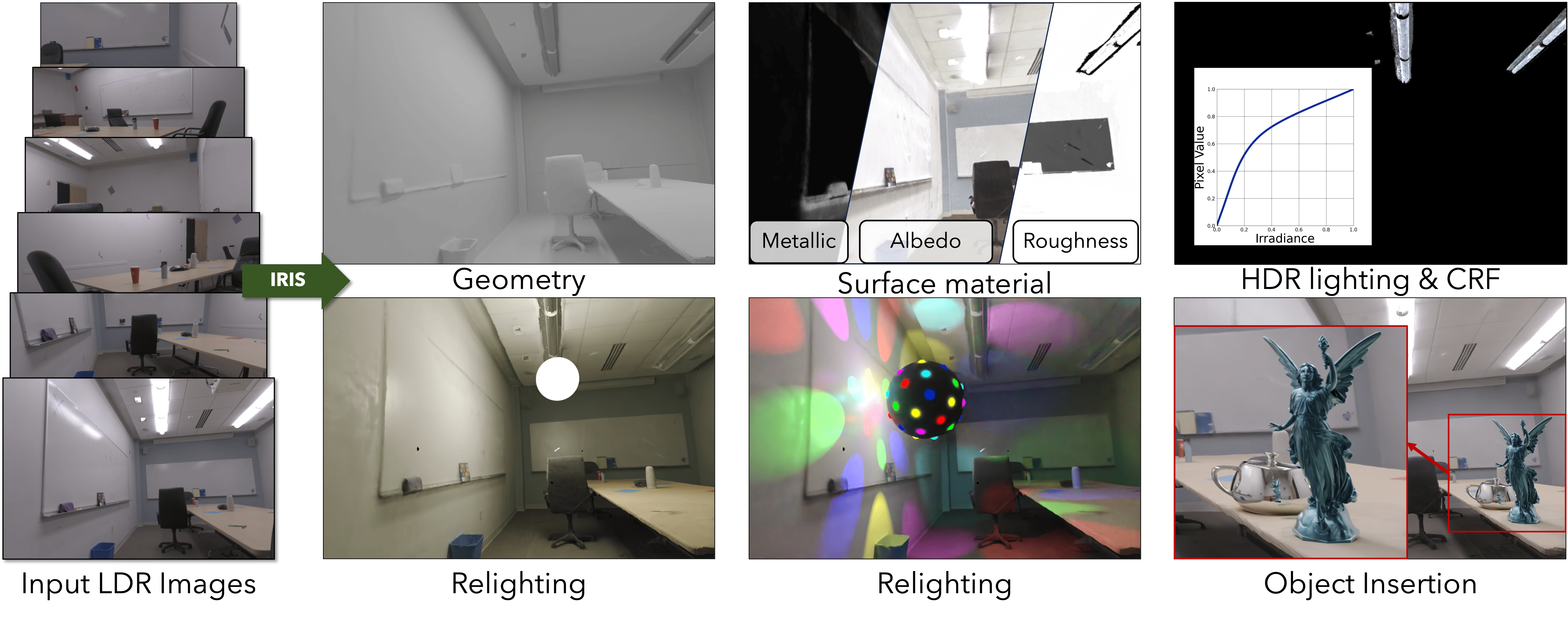CVPR 2025
Project Page | Paper | Data | Checkpoints
Chih-Hao Lin1,2,
Jia-Bin Huang1,3,
Zhengqin Li1,
Zhao Dong1,
Christian Richardt1,
Tuotuo Li1,
Michael Zollhöfer1,
Johannes Kopf1,
Shenlong Wang2,
Changil Kim1
1Meta, 2University of Illinois at Urbana-Champaign, 3University of Maryland, College Park
The code has been tested on:
- OS: Ubuntu 22.04.4 LTS
- GPU: NVIDIA GeForce RTX 4090
- Driver Version: 535
- CUDA Version: 12.2
- nvcc: 11.7
Please install anaconda/miniconda and run the following script to set up the environment:
bash scripts/conda_env.shThe package information details can be found in environment.yml.
- Please download datasets and edit the paths (
DATASET_ROOT) in training/rendering scripts accordingly. We provide 8 scenes in total, including 2 real scenes from ScanNet++ (scannetpp/), 2 real scenes from FIPT (fipt/real/), and 4 synthetic scenes from FIPT (fipt/indoor_synthetic/).- Geometry is reconstructed and provided for each scene.
- While HDR images (
*.exr) are not used by IRIS, they are also provided for FIPT scenes.
- Please download checkpoints and put under
checkpoints. We provide checkpoints of all the scenes in the dataset.
The training scripts are scripts/{dataset}/{scene}/train.sh. For example, please run the following to train at bathroom2 scene in ScanNet++:
bash scripts/scannetpp/bathroom2/train.shThe hyper-parameters are listed in configs/config.py, and can be adjusted at the top of the scripts. The training contains several stages:
- Bake surface light field (SLF), and save as
checkpoints/{exp_name}/bake/vslf.npz:
python slf_bake.py --dataset_root $DATASET_ROOT --scene $SCENE\
--output checkpoints/$EXP/bake --res_scale $RES_SCALE\
--dataset $DATASET- Extract emitter mask, and save as
checkpoints/{exp_name}/bake/emitter.pth:
python extract_emitter_ldr.py \
--dataset_root $DATASET_ROOT --scene $SCENE\
--output checkpoints/$EXP/bake \
--dataset $DATASET --res_scale $RES_SCALE\
--threshold 0.99 - Initialize BRDF and emitter radiance:
python initialize.py --experiment_name $EXP --max_epochs 5 \
--dataset $DATASET $DATASET_ROOT --scene $SCENE \
--voxel_path checkpoints/$EXP/bake/vslf.npz \
--emitter_path checkpoints/$EXP/bake/emitter.pth \
--has_part $HAS_PART --val_frame $VAL_FRAME\
--SPP $SPP --spp $spp --crf_basis $CRF_BASIS --res_scale $RES_SCALE- Update emitter radiance:
python extract_emitter_ldr.py --mode update\
--dataset_root $DATASET_ROOT --scene $SCENE\
--output checkpoints/$EXP/bake --res_scale $RES_SCALE\
--ckpt checkpoints/$EXP/init.ckpt\
--dataset $DATASET- Bake shading maps, and save in
outputs/{exp_name}/shading:
python bake_shading.py \
--dataset_root $DATASET_ROOT --scene $SCENE \
--dataset $DATASET --res_scale $RES_SCALE\
--slf_path checkpoints/$EXP/bake/vslf.npz \
--emitter_path checkpoints/$EXP/bake/emitter.pth \
--output outputs/$EXP/shading - Optimize BRDF and camera CRF:
python train_brdf_crf.py --experiment_name $EXP \
--dataset $DATASET $DATASET_ROOT --scene $SCENE\
--has_part $HAS_PART --val_frame $VAL_FRAME --res_scale $RES_SCALE\
--max_epochs 2 --dir_val val_0 \
--ckpt_path checkpoints/$EXP/init.ckpt \
--voxel_path checkpoints/$EXP/bake/vslf.npz \
--emitter_path checkpoints/$EXP/bake/emitter.pth \
--cache_dir outputs/$EXP/shading \
--SPP $SPP --spp $spp --lp 0.005 --la 0.01 \
--l_crf_weight 0.001 --crf_basis $CRF_BASIS- Refine surface light field:
python slf_refine.py --dataset_root $DATASET_ROOT --scene $SCENE \
--output checkpoints/$EXP/bake --load vslf.npz --save vslf_0.npz \
--dataset $DATASET --res_scale $RES_SCALE\
--ckpt checkpoints/$EXP/last_0.ckpt --crf_basis $CRF_BASIS- Refine emitter radiance:
python train_emitter.py --experiment_name $EXP \
--dataset $DATASET $DATASET_ROOT --scene $SCENE\
--has_part $HAS_PART --val_frame $VAL_FRAME --res_scale $RES_SCALE\
--max_epochs 1 --dir_val val_0_emitter \
--ckpt_path checkpoints/$EXP/last_0.ckpt \
--voxel_path checkpoints/$EXP/bake/vslf_0.npz \
--emitter_path checkpoints/$EXP/bake/emitter.pth \
--SPP $SPP --spp $spp --crf_basis $CRF_BASIS- Refine shading maps:
python refine_shading.py \
--dataset_root $DATASET_ROOT --scene $SCENE \
--dataset $DATASET --res_scale $RES_SCALE\
--slf_path checkpoints/$EXP/bake/vslf_0.npz \
--emitter_path checkpoints/$EXP/bake/emitter.pth \
--ckpt checkpoints/$EXP/last_0.ckpt \
--output outputs/$EXP/shadingThe rendering scripts are scripts/{dataset}/{scene}/render.sh. For example, please run the following for bathroom2 scene in ScanNet++:
bash scripts/scannetpp/bathroom2/render.shThe scripts contain three parts:
- Render train/test frames, including RGB, BRDF, and emission maps. The output is saved at
outputs/{exp_name}/output/{split}:
python render.py --experiment_name $EXP --device 0\
--ckpt last_1.ckpt \
--dataset $DATASET $DATASET_ROOT --scene $SCENE\
--res_scale $RES_SCALE\
--emitter_path checkpoints/$EXP/bake\
--output_path 'outputs/'$EXP'/output'\
--split 'test'\
--SPP $SPP --spp $spp --crf_basis $CRF_BASIS - Render videos of RGB, BRDF, and emission maps. The output is saved at
outputs/{exp_name}/video:
python render_video.py --experiment_name $EXP --device 0\
--ckpt last_1.ckpt \
--dataset $DATASET $DATASET_ROOT --scene $SCENE \
--res_scale $RES_SCALE\
--emitter_path checkpoints/$EXP/bake\
--output_path 'outputs/'$EXP'/video'\
--split 'test'\
--SPP $SPP --spp $spp --crf_basis $CRF_BASIS - Render relighting videos. The output is saved at
outputs/{exp_name}/relight:
python render_relight.py --experiment_name $EXP --device 0\
--ckpt last_1.ckpt --mode traj\
--dataset $DATASET $DATASET_ROOT --scene $SCENE \
--res_scale $RES_SCALE \
--emitter_path checkpoints/$EXP/bake\
--output_path 'outputs/'$EXP'/relight/video_relight_0'\
--split 'test'\
--light_cfg 'configs/scannetpp/bathroom2/relight_0.yaml' \
--SPP $SPP --spp $spp --crf_basis $CRF_BASIS - The relighting config files are
configs/{dataset}/{scene}/*.yaml, and are input for parameter--light_cfg, generating different relighting results. - For object insertion, the emitter geometry and average radiance are extracted with
scripts/extract_emitter.sh. The assets for insertion can be downloaded here and put underoutputs.
The inverse rendering metric of FIPT synthetic scenes is calculated by (please modify the paths accordingly):
python -m utils.metric_brdf- The camera poses can be estimated with NeRFstudio pipeline (
transforms.json). - The surface albedo is estimated with IRISFormer, and can be replaced with RGB-X for even better performance.
- Surface normal is estimated with OmniData for geometry reconstruction, and can be replaced with more recent works for even better performance.
- Geometry is reconstructed with BakedSDF in SDFStudio. We use customized version and run the following:
# Optimize SDF
python scripts/train.py bakedsdf-mlp \
--output-dir [output_dir] --experiment-name [experiment_name] \
--trainer.steps-per-eval-image 5000 --trainer.steps-per-eval-all-images 50000 \
--trainer.max-num-iterations 250001 --trainer.steps-per-eval-batch 5000 \
--pipeline.model.sdf-field.bias 1.5 \
--pipeline.model.sdf-field.inside-outside True \
--pipeline.model.eikonal-loss-mult 0.01 \
--pipeline.model.num-neus-samples-per-ray 24 \
--machine.num-gpus 1 \
--pipeline.model.mono-normal-loss-mult 0.1 \
panoptic-data \
--data [path_to_data] \
--panoptic_data False --mono_normal_data True --panoptic_segment False \
--orientation-method none --center-poses False --auto-scale-poses False
# Extract mesh
python scripts/extract_mesh.py --load-config [exp_dir]/config.yml \
--output-path [exp_dir]/mesh.ply \
--bounding-box-min -2.0 -2.0 -2.0 --bounding-box-max 2.0 2.0 2.0 \
--resolution 2048 --marching_cube_threshold 0.001 \
--create_visibility_mask True --simplify-mesh TrueIRIS is CC BY-NC 4.0 licensed, as found in the LICENSE file.
If you find our work useful, please consider citing:
@inproceedings{lin2025iris,
title = {{IRIS}: Inverse rendering of indoor scenes from low dynamic range images},
author = {Lin, Chih-Hao and Huang, Jia-Bin and Li, Zhengqin and Dong, Zhao and
Richardt, Christian and Li, Tuotuo and Zollh{\"o}fer, Michael and
Kopf, Johannes and Wang, Shenlong and Kim, Changil},
booktitle = {Conference on Computer Vision and Pattern Recognition (CVPR)},
year = {2025}
}Our code is based on FIPT. Some experiment results are provided by the authors of I^2-SDF and Li et al. We thank the authors for their excellent work!
